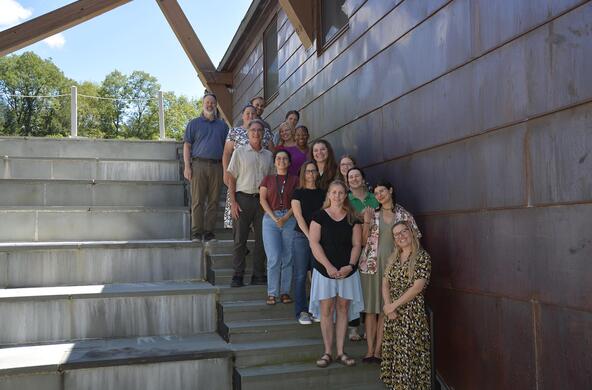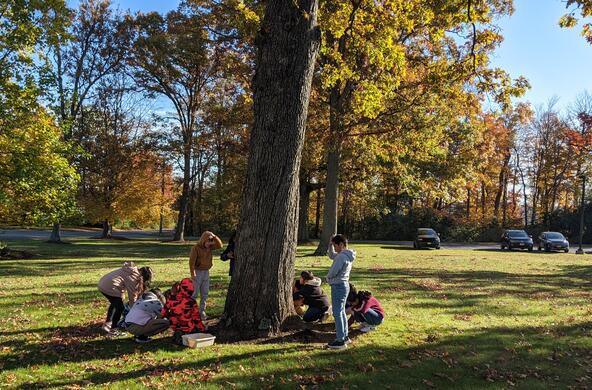Like many of us, Kevin Burgio, Undergraduate Program Leader and Research Specialist at Cary Institute, has spent the past few months working from home. This isn’t new for him. Burgio has been working remotely on and off for the past nine years, and he’s gotten pretty good at it. Having experienced the merits of remote work firsthand, Burgio was inspired to share tips on ways to make remote research positions viable.
Recently published in the journal Computational Biology, Burgio’s paper Ten simple rules for a successful remote postdoc synthesizes the voices and experiences of a team of remote postdocs and university faculty that support remote lab members. Their goal: to encourage heads of labs to consider offering remote options for positions that do not require researchers to work onsite.
While searching for a postdoctoral position, Burgio found himself frustrated by the lack of opportunities for people like him, whose family situation necessitates remote work. “I’m a computational biologist, so I don’t physically need to be in a lab or in the field to do my work. I’m also a parent, and that’s a job I need to be present for.”
Burgio voiced his thoughts on Twitter and was encouraged by the outpouring of support he received on the platform. His friend and co-lead author Caitlin Mackenzie, a remote postdoc currently working with dual affiliations at the Climate Change Institute, University of Maine, Orono, and the Society for Conservation Biology, Washington, DC, suggested he write a paper on the subject.

Ten simple rules for a successful remote postdoc offers practical ideas to make remote postdoc positions work. Here’s a summary of their top tips:
- Recognize and embrace the benefits of remote postdocs.
- Plan for remote work at the outset of the position.
- Establish a communication plan early.
- Invest in and use video conferencing.
- Normalize remote interactions and cultivate digital spaces for the entire lab.
- Treat remote postdocs as full members of the lab.
- A little in-person interaction goes a long way; maximize it by being creative.
- Actively work to combat isolation.
- Develop adaptive problem-solving skills.
- Own and promote mentoring or being a remote postdoc.
Burgio insists that investing in technology to support virtual communication is essential: “Good video conferencing equipment, including software and hardware, can drastically improve the experience of both the postdoc and the principal investigator. Investing in workplace messaging applications can be helpful too, as my collaborators and I found when writing this paper.”

The authors also highlight issues of equity in STEM fields. Burgio explains that barriers posed by the logistics of in-person positions might discourage potential candidates from applying. Offering more remote options could become an important way to promote inclusivity in STEM fields.
“The costs associated with undertaking in-person postdoc positions are magnified for researchers from underrepresented groups, such as first-generation students, who are less likely to have access to financial resources for moving and counteracting the loss of their support networks at home,” Burgio says.
When Burgio and his co-authors began working on the paper, they had no idea that soon, many people all over the world would be forced to work from home. “I think COVID-19 is going to change perceptions of remote work,” Burgio says. “I finish at Cary in August, and I recently emailed a lab about a postdoc position. I told them that I can’t move, and they said that COVID has shown them how much can be done remotely and encouraged me to apply.”

For younger scientists starting to build their own labs, the idea of hiring remote lab members might seem less than ideal; in-person mentoring among lab members at different career stages is an important part of a healthy lab dynamic, and this can be tricky to cultivate from afar. However, Burgio is optimistic that as more scientists who grew up using digital devices open their own labs, remote work will become more common.
“Even before COVID hit, remote work was starting to become popular in many fields. Now that COVID has made at-home work a requirement for many, employers are realizing – on a large scale – that working from home can be very productive. Further, as people pay more attention to the social justice aspects of remote work and appreciate that it is a way to engage more underrepresented researchers, I’m hopeful that there will be greater reception.”
Citation
Burgio KR, MacKenzie CM, Borrelle SB, Ernest SKM, Gill JL, Ingeman KE, et al. (2020) Ten Simple Rules for a successful remote postdoc. PLoS Comput Biol 16(5): e1007809. https://doi.org/10.1371/journal.pcbi.1007809






